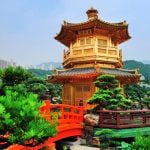The Hanging Gardens of Babylon have captured the imagination of people for centuries, with their elusive beauty and impressive engineering. If you’ve ever been inspired by this ancient wonder and are looking for project ideas, you’ve come to the right place.
In this article, we will delve into the history, design, and cultural significance of the Hanging Gardens of Babylon in order to provide you with the inspiration and information needed to create your own Babylonian-inspired garden. From exploring the possible structures and layout to choosing the right plants and incorporating eco-friendly elements, this article will guide you through various aspects of bringing the Hanging Gardens of Babylon to life.
The mystery behind the Hanging Gardens has long intrigued historians and archaeologists. While some debate whether they were real or simply a part of mythological lore, there is consensus that they were a feat of ingenious design and engineering. By unraveling the history and myth surrounding these gardens, we can gain insight into their cultural significance and influence on future architectural endeavors.
Further exploration into the design and architecture of the gardens will open up numerous possibilities for creating a modern replica. From innovative irrigation systems to recreating the lush vegetation that adorned the original gardens, there are many exciting project ideas waiting to be discovered. Join us in uncovering all there is to know about this ancient wonder and finding inspiration for your own Hanging Gardens of Babylon project.
History and Myth
The Hanging Gardens of Babylon have long been a source of fascination and mystery, with historians and archaeologists debating the existence and location of these legendary gardens. The history and myth surrounding the gardens add an air of intrigue to the project. Unraveling the mystery behind the Hanging Gardens involves delving into ancient texts, accounts from travelers, and archaeological evidence to piece together the story of this wonder of the ancient world.
Historical Accounts and Interpretations
Various historical texts, including those by Greek historians such as Strabo and Philo of Byzantium, provide accounts of the Hanging Gardens. These descriptions often differ in their details, leading to speculation about the gardens’ actual location and layout. Understanding these historical accounts is crucial in gaining insight into the origins and possible design of the gardens.
Debunking Myths and Legends
Separating fact from fiction is essential when unraveling the mystery behind the Hanging Gardens. While myths and legends may have added to the allure of this ancient marvel, distinguishing reality from embellishment is key to creating an accurate representation or modern replica. Debunking misconceptions can also reveal important clues about the actual existence and nature of the gardens.
Archaeological Discoveries
Recent archaeological excavations at sites such as Babylon in modern-day Iraq have shed light on ancient irrigation systems, palaces, and other structures that may offer insights into the elusive Hanging Gardens. By examining these discoveries alongside historical records, researchers can further unravel the mystery behind this UNESCO World Heritage Site.
Design and Architecture
The design and architecture of the Hanging Gardens of Babylon have been the subject of much speculation and fascination throughout history. While there is no concrete evidence to verify their existence, ancient texts and archaeological findings have provided some clues about their potential structures and layout.
To recreate the splendor of the fabled gardens, consider the following elements for your project:
- Multilevel terraces: The gardens were said to be constructed in a series of ascending terraces, resembling a green mountain rising from the earth. Incorporating this tiered structure into your design can create a visually stunning effect.
- Water features: A crucial aspect of the Hanging Gardens was their advanced irrigation system, which allowed for the flourishing of vegetation in a dry environment. Integrate water channels, fountains, and cascades into your garden to emulate this vital component.
- Architectural embellishments: The use of ornate columns, archways, and decorative motifs would have adorned the garden, adding to its grandeur. Incorporating Babylonian-inspired architectural elements can enhance the authenticity of your project.
By carefully considering these aspects of design and architecture, you can begin to bring the essence of the Hanging Gardens to life in your own project.
While creating a modern replica of the Hanging Gardens is undoubtedly an ambitious undertaking, innovative engineering concepts can help make this dream a reality. To achieve this feat, here are some ideas for consideration:
- Hydroponic systems: Implementing hydroponic technology can provide an efficient method for growing plants without soil. This approach could closely mimic the original construction methods used in ancient Babylon while offering sustainable benefits.
- Sustainable materials: Utilize environmentally-friendly materials such as reclaimed wood, recycled metal, and eco-friendly concrete alternatives in the construction process. This mindful selection can reduce environmental impact while honoring historical construction practices.
- Green infrastructure: Integrate modern green infrastructure practices such as rainwater harvesting systems, vertical gardens, and solar-powered irrigation to ensure sustainability and environmental stewardship within your project.
By incorporating these technological advancements into your design plans, you can strive to create a contemporary interpretation that pays homage to the engineering marvels attributed to the legendary Hanging Gardens.
Ultimately, exploring various interpretations of how the Hanging Gardens might have appeared allows us to engage with history while delving into architectural creativity. By utilizing these considerations in your project planning stage, you will be well on your way towards realizing your own rendition of this ancient wonder.
Engineering and Irrigation
When it comes to recreating the Hanging Gardens of Babylon, one of the most crucial aspects to consider is the engineering and irrigation system. The ancient Babylonians were able to create a stunning oasis in the desert, thanks to their innovative methods of water distribution and irrigation. To bring this wonder of the ancient world back to life, modern project planners will need to think outside the box and explore cutting-edge techniques for replicating these ancient systems.
Here are some innovative ideas for creating a modern replica of the gardens:
- Utilizing advanced hydroponic or aeroponic systems to grow plants without soil, mimicking the soil-free gardening methods believed to have been employed in the original Hanging Gardens.
- Incorporating sustainable water management practices such as rainwater harvesting, greywater recycling, and drip irrigation to minimize water usage and environmental impact.
- Implementing automated climate control technologies and smart irrigation systems that can monitor and adjust watering schedules based on real-time weather conditions, ensuring optimal growing conditions for the plants.
By integrating these modern engineering and irrigation solutions into the project plan, it becomes possible to recreate the awe-inspiring beauty of the Hanging Gardens while also addressing concerns about resource conservation and ecological sustainability. These innovative approaches can offer a fresh perspective on how we can honor an ancient marvel while adapting it to fit our contemporary needs and values.
Ultimately, by embracing forward-thinking technologies and principles, project planners can channel the ingenuity of the ancient Babylonians while also showcasing our own advancements in environmental stewardship. Through careful planning and strategic implementation, a modern replica of the Hanging Gardens has the potential to captivate visitors with its historical allure while inspiring them with its environmentally conscious design.
Botanical and Plant Selection
When creating a Babylonian-inspired garden, choosing the right plants is crucial to achieving an authentic ambiance. The Hanging Gardens of Babylon were known for their lush greenery and exotic flora, so it’s important to select plants that capture the essence of this ancient wonder. Here are some key considerations for botanical and plant selection in your project:
Historical Research and Documentation
Before embarking on your planting journey, it’s essential to conduct thorough research on the types of plants that were believed to have adorned the original Hanging Gardens. While there is much debate and speculation about the exact plant species used in the ancient gardens, historical records and accounts can provide valuable insights. Consulting with experts in ancient horticulture or botany can also offer valuable guidance in choosing historically accurate plants.
Diversity and Contrast
To recreate the opulent beauty of the Hanging Gardens, consider incorporating a diverse range of plant species to provide visual interest and contrast. Perhaps include vibrant flowers such as iris, lilies, or roses alongside cascading vines like wisteria or jasmine. Additionally, incorporating various foliage textures – such as broad-leafed plants like palms or ferns – can add depth and complexity to your garden design.
Adaptation to Climate and Environment
When selecting plants for your Babylonian-inspired garden, it’s important to consider their adaptability to your local climate and environmental conditions. Given that the original Hanging Gardens were located in a desert environment, you may want to explore drought-resistant species or use innovative irrigation methods to maintain a flourishing landscape. Additionally, integrating native flora into your design can help promote sustainability while paying homage to the ecological context of the original gardens.
By carefully considering historical accuracy, visual appeal, and environmental suitability during botanical selection, you can create an awe-inspiring Babylonian-inspired garden that captures the essence of the fabled Hanging Gardens of Babylon.
Sustainability and Environmental Impact
The concept of sustainability and environmental impact holds great importance when it comes to creating a modern replica of the Hanging Gardens of Babylon. In order to ensure that the project is not only visually stunning but also environmentally friendly, it is crucial to incorporate eco-friendly elements into the design and implementation.
One key aspect of sustainability in this project is the choice of materials. Using recycled or reclaimed materials for the construction of the garden structures can significantly reduce the project’s carbon footprint. Additionally, implementing green building techniques, such as proper insulation and energy-efficient lighting, can further enhance the sustainability of the project.
Another essential consideration is water conservation. The original Hanging Gardens were an engineering marvel in terms of irrigation, using a system of water channels and terracotta pipes to keep the plants thriving. In a modern interpretation, utilizing rainwater harvesting techniques and drip irrigation systems can help minimize water usage while still ensuring that the plants receive adequate hydration.
Furthermore, incorporating native and drought-resistant plants into the botanical selection can contribute to the environmental sustainability of the project. By choosing plant species that are well adapted to the local climate and require minimal watering, the modern-day Hanging Gardens can thrive without putting excessive strain on natural resources.
| Aspect | Consideration |
|---|---|
| Choice of Materials | Using recycled or reclaimed materials for construction |
| Water Conservation | Rainwater harvesting and drip irrigation systems |
| Botanical Selection | Incorporating native and drought-resistant plants |
Cultural and Educational Significance
The Hanging Gardens of Babylon are one of the most iconic and mysterious wonders of the ancient world. Their cultural and educational significance cannot be overstated, as they represent a remarkable feat of engineering and design that has fascinated scholars and historians for centuries. In addition to their historical value, the gardens have also captured the imaginations of artists, architects, and garden enthusiasts, inspiring numerous projects and designs.
One of the most intriguing aspects of the Hanging Gardens is their role in ancient cultural and educational contexts. According to historical accounts, the gardens were created by King Nebuchadnezzar II for his wife Amytis, who longed for the lush vegetation of her homeland.
This romantic gesture not only highlights the importance of nature and beauty in ancient societies but also serves as a symbol of love and devotion. The gardens’ inclusion in various historical texts and depictions further emphasizes their cultural significance as a source of inspiration for art, literature, and even scientific endeavors.
Recreating the Hanging Gardens through modern projects can offer valuable educational opportunities. Students, researchers, and garden enthusiasts can learn about ancient irrigation techniques, plant selection methods, and architectural principles by studying this historical marvel. By engaging in hands-on projects that aim to replicate or interpret the gardens’ design, individuals can gain a deeper understanding of history, engineering, horticulture, and environmental sustainability.
Lastly, it is important to acknowledge the influence of the Hanging Gardens on contemporary culture and society. Whether through fictional portrayals in literature or visual media or through real-life efforts to create gardens inspired by Babylonian aesthetics, these ancient wonders continue to spark creativity and curiosity around the world.
By discussing their educational and historical value, we can ensure that future generations appreciate the significance of the Hanging Gardens of Babylon as both a cultural landmark and an enduring source of inspiration.
| Cultural Significance | Educational Value |
|---|---|
| Represents a remarkable feat of ancient engineering | Offers valuable learning opportunities in history, horticulture & architecture |
| Serves as a symbol of love & devotion in ancient cultures | Engages students & researchers in hands-on projects for deeper understanding |
| Influences contemporary culture & creative endeavors worldwide | Encourages appreciation for historical landmarks & enduring sources of inspiration |
Project Implementation
In conclusion, the Hanging Gardens of Babylon project offers a fascinating opportunity to delve into history, engineering, and horticulture. By tackling this ambitious project, individuals can not only pay homage to one of the ancient world’s most awe-inspiring wonders but also explore innovative ideas for creating a modern replica of the gardens.
Whether it’s through incorporating cutting-edge engineering techniques or carefully selecting botanical species that mimic the flora of ancient Babylon, this project provides a platform for creativity and exploration.
Furthermore, bringing the Hanging Gardens of Babylon project to life is not just an exercise in design and construction; it also holds significant educational and cultural value. By undertaking this endeavor, individuals have the chance to educate others on the historical significance of the gardens and their connection to ancient Mesopotamian culture. Additionally, the process of implementing such a large-scale project can serve as a valuable learning experience for students interested in architecture, engineering, or environmental sustainability.
Ultimately, with careful planning, dedication, and access to resources related to historical research, architectural design, landscaping principles, and sustainable practices, embarking on a Hanging Gardens of Babylon project can be a rewarding endeavor. Through collaboration with experts in various fields and leveraging modern technology while honoring ancient traditions, aspiring garden enthusiasts and history buffs alike can find inspiration by reimagining one of the world’s most legendary marvels.
Frequently Asked Questions
What Was Included in the Hanging Gardens of Babylon?
The Hanging Gardens of Babylon were said to include terraced gardens, adorned with a variety of trees, shrubs, and vines. It is believed that the gardens had a complex irrigation system to support the extensive vegetation.
What Was the Design Concept of the Hanging Gardens of Babylon?
The design concept of the Hanging Gardens was to create an artificial mountain-like structure with lush greenery. The terraces were built one above the other with strong vaults supporting the upward sloping gardens. The intention was to simulate nature in an urban environment.
Why Is the Hanging Gardens of Babylon Is Controversial?
The controversy surrounding the Hanging Gardens of Babylon stems from the lack of concrete evidence proving its existence. While there are historical accounts and descriptions of the gardens, archaeologists have not found direct physical evidence such as inscriptions or artifacts that definitively prove its existence.
This has led to debates among historians and scholars about whether the gardens were a real architectural marvel or simply a legendary tale.

Welcome to my gardening blog! I am passionate about plants and enjoy sharing my knowledge and experiences with others. In this blog, I will write about everything related to gardening, from tips on how to get started to updates on my own garden projects.





